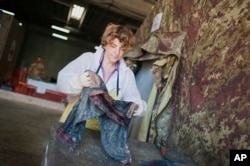An acclaimed Italian forensic scientist has for years had the difficult job of identifying bodies of migrants, who sought to reach Europe in search of a better life but never made it. Cristina Cattaneo says it is complicated process but an important one for the families of the victims.
At least 30,000 migrants are believed to have perished in the Mediterranean Sea in their efforts to reach Europe. Of these, more than half have not been identified. For some years now, Cattaneo has been trying to improve that situation. But giving a name to migrants who died is no easy matter, particularly because there is no databank of missing migrants.
Cattaneo said what is needed is to put post-mortem details of dead migrants into a single database to match with pre-mortem details that must be gathered from relatives looking for their loved ones. She initially encountered resistance: there were no public funds available for that kind of work and criticism included the fact that no one was looking for the nameless migrants. But she disagreed.
Cattaneo said she felt the “anxiety of relatives searching for their dead and how they have the right to find them and be given their death certificates.” She said the initiative began in 2012 to afford relatives the same dignity that is given to victims of other disasters, like plane crashes. She said “the discrimination toward dead migrants” is wrong.
The catalyst for proper identification of nameless migrants, Cattaneo said, came in the form of two major disasters that occurred in the Mediterranean: the sinking of a vessel off the island of Lampedusa on October 3, 2013, in which more than 360 migrants died, and an incident off the Libyan coastline on April 18, 2015, in which a vessel carrying more than 800 migrants sank to the bottom of the Mediterranean. Later reports said that up to 1,100 hundred migrants could have been aboard the doomed vessel.
For both of these tragedies, forensic scientists gathered post-mortem information, including DNA, for all those recovered, in an effort to identify the migrants. In the case of the 2015 sinking, the operation was complex because many of the bodies recovered one year later were decomposed, and the vessel had to be raised from a depth of 400 meters by the Italian navy.
Cattaneo explained that identifying victims’ remains is also important from a legal point of view.
She said that orphans — especially minors — and widows often need death certificates of their relatives or it is very difficult for them to legally move forward with their lives.
After collecting and profiling the information gathered from the victims, Cattaneo said they needed to gather pre-mortem information from living relatives. In the case of the vessel that sank off Lampedusa, the Italian government put out a call for anyone who thought they may have had a family member who died in that disaster to come forward with details that could be matched against data gathered by forensic scientists.
Cattaneo said 72 relatives came forward, leading to the positive identification of 35 dead migrants, and their cases were closed.
For the ship that was recovered from the bottom of the sea, the International Red Cross put out a call for the likely relatives to come forward. One-hundred-ninety relatives from Mali and Mauritania alone responded to that call. Cattaneo and her team are continuing their identification efforts at a forensic laboratory at Milan University.
Italy is the only country in Europe that has embarked on a project like this using post-mortem and pre-mortem information matching for migrants. Underscoring the many hurdles in this process, Cattaneo saaid the only way forward is for a databank to be created in which European countries share information, similar to how law enforcement officials currently operate.






